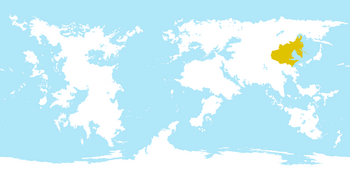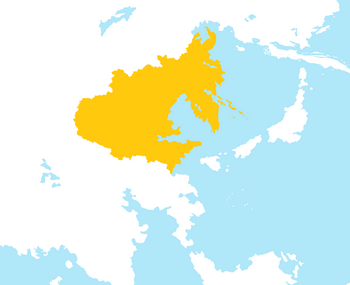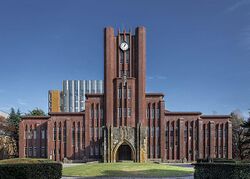Zhenia
Greater Eastern Union of Zhenia 大東真國聯邦 대동진국연방 | |
|---|---|
| Motto: ""民有, 民治, 民享"." | |
| Anthem: Hymn for Democracy | |
 Location of Zhenia in the world in gold. | |
 A map of Zhenia in Northeast Asia. | |
| Capital and largest city | Donggyeong |
| Official languages | Zhenian |
| Other languages | |
| Ethnic groups (2019) |
|
| Demonym(s) | Zhenian |
| Government | Federal Semi-Presidential Republic |
• Premier | Lee Saemin |
| Kim Junghun | |
| Legislature | Parliament of the Greater Eastern Union |
| Senate | |
| Federal Assembly | |
| Establishment | |
• as the Shindan dynasty | July 3, 1298 |
• as the Empire of Greater Wu | January 5, 1567 |
• as the Empire of Zhenia | August 3, 1868 |
• as current form | December 1, 1979 |
| Area | |
• | 6,391,077.1 km2 (2,467,608.7 sq mi) |
• Water (%) | 3.39% |
| Population | |
• 2019 estimate | 476.9 million |
• 2019 census | 476,974,471 |
| GDP (PPP) | 2019 estimate |
• Total | $15.36 trillion |
• Per capita | $32,228.1 |
| GDP (nominal) | 2019 estimate |
• Total | $15.24 trillion |
• Per capita | $31,982.7 |
| Gini (2019) | medium |
| HDI (2017) | very high |
| Currency | Zhenian Won (ZKW) |
| Time zone | UTC+7, +8, +9 (Zhenia Western Standard Time (ZWST), Zhenia Central Standard Time (ZCST), Zhenia Eastern Standard Time (ZEST)) |
| Date format | mm-dd-yyyy |
| Driving side | right |
| Calling code | +11 |
| Internet TLD | .zh/.zhen/.geu |
Zhenia (Classic Zhenian: 真國, Modern Zhenian: 진국), formally known as the Greater Eastern Union of Zhenia (Classic Zhenian: 大東真國聯邦, Modern Zhenian: 대동진국연방), is a federal semi-presidential republic consisting of 28 provinces, 5 metropolitan municipalities (Jinhae, Changan, Shinhang, Bakhan and Ariul) and one capital district. Spanning across 6,391,077.1 km2 over both the mainland and the Danguk Peninsula, it is the third-largest in the world by territorial size, following the Northern Confederation and Hijjma. It is bordered by numerous entities in the region and faces the North Zhenian Sea and East Zhenian Sea to its northeast and east.
Civilization emerged in both mainland Zhenia and the Danguk Peninsula by 2,000 BCE. The Liang Dynasty came to existence in central Zhenia around 1800 BCE, while the semi-legendary State of Danguk was founded around 2000 BCE. Since then, much of Zhenian history consisted of hereditary monarchies, or dynasties, and their expansion, fracture and replacement by other entities. In 322 BCE, the Zhen dynasty, led by Shen Lien, became the first dynasty to unify both the Danguk Peninsula and mainland Zhenia, assimilating mainland Zhenian cultural elements into those of the Danguk Peninsula and establishing the Zhenian identity over the centuries it existed. Mainland Zhenia and the Danguk Peninsula were ruled by separate entities following the Zhen's collapse in the 6th century, although numerous successive dynasties attempted reunification. The reunification arrived during the last stages of the Shindan dynasty, when Emperor Seongjong, reformed the former backwater tributary state into a great power through leveraging the interests of Auroran powers and rapid industrialization with the cooperation of Husgratin and Zonnenbord. The Shindan waged numerous wars in the 1840s and 1850s, ultimately collapsing the Empire of Greater Wu and reunifying Zhenia into the Greater Eastern Union on June 4, 1868.
Zhenia's resurgence in the late 19th century resulted in the Shinzhen Movement, leading to numerous wars against existing Auroran colonial powers within its sphere of influence. Industrialization and initial victory against Aurorans resulted in the advent of militarism and ultra-nationalism. Its victory in the First Great War confirmed its status as a global military power, possibly surpassing the potential of existing Auroran powers. Zhenian causing and involvement in the Second Great War in 1947 ended in Zhenian Surrender. In 1953, a military junta led by Kim Shimin was established through the Coup of 1953, with the regime ultimately propelling the nation's rapid economic development often referred to as the Miracle of the Jin River. The November Revolution of 1979 brought an end to the Fourth Republic and resulted in the democratization of Zhenia and the subsequent declaration of the Fifth Republic. To this day, Zhenia remains a democratic republic.
As of 2019, Zhenia is both the largest economy in the world by nominal GDP at around $15.24 trillion and by GDP purchasing power parity (PPP) at $15.36 trillion, while it is also the largest exporter and second-largest importer of goods. It is a global leader in industrial and technological sectors, with its export-driven economy focusing on electronics, aerospace, automobiles, shipbuilding and robotics. It has the largest defense budget in the world at around $774 billion and has been a nuclear weapons state since 1959. In recent times, Zhenia has been characterized as a global great power, while estimates claim it will achieve superpower status by 2030.
Etymology
History
Antiquity
Main Article: History of Ancient Zhenia
Mainland Zhenia
Main Article: History of Mainland Zhenia
Danguk Peninsula
Main Article: History of Zhenia (Danguk Peninsula)
In 1298, General Seok Juwon, with popular support for a new age, overthrew the Southern Han after a successful military coup against it, founding the Shindan dynasty the same year. Adopting the teachings of Kim Dojin as the nation's official ideology, the Shindan originally adopted a political structure centered around the Premier rather than the King. While also leading the decades-long war against the Kharlin Empire to the north, power was centralized around the King as successive rulers consolidated their authority through successful campaigns against the Kharlins. After it drove away the Kharlins from the Danguk peninsula, an equilibrium between the warrior class and scholar-officials was reached, as both classes passed down their positions and wealth to continue lives of practice and political participation.
The Shindan was the first Danguan entity after the Zhen's demise that was at diplomatically equal terms with mainland Zhenian dynasties, exerting control over its own tributary states in Southeast Asia. While it maintained diplomatically equal relations with the Zhu dynasty since its establishment, Shindan later challenged the Greater Wu around the 17th century, when the Zhu began to crumble. Shindan was invaded by the Greater Wu in 1621, 1633 and 1667, resulting in Shindan falling under a tributary system with the Greater Wu. Amid an era of new peace, the scholar-officials gained an upper hand over the warrior class and dominated major governmental positions in the 17th and 18th centuries, ultimately leading to mass corruption and weakening of the state.
In 1830, when King Seongjo came to power, introduced numerous reforms to Shindan, once again concentrating power to the monarchy and cracking down on the scholar-officials. It was also during King Seongjo's era that Shindan underwent massive industrialization and changes that transformed Shindan from a backwater feudal tributary into a westernized power through leveraging the varied interests of Auroran colonial powers in the region, signing diplomatic treaties with Zonnenbord and Husgratin earlier than any other East Asian nation. Adopting Auroran technology and systems into the former hermit kingdom, Shindan won the approval of Auroran colonial empires and became the first nation in the region to have a modernized army. With increased military forces, it challenged the Mandate of Heaven held by the Greater Wu and defeated it in 1844 and 1849, seizing most of Yemeg and Balakhaat territory. After claiming himself as Emperor and Great Khan of the Yemeg and Balakhaat people in 1851, Seongjo led the final push into the Greater Wu himself the following year, when Greater Wu was disbanded into multiple tributary kingdoms and executed Emperor Aizong, declaring an end to the existing world order centered around mainland Zhenia. The temporary peace after the division of Greater Wu came to an end as Shindan employed a divide and conquer strategy throughout mainland Zhenia and conquered each of the divided kingdoms, ultimately unifying all of Zhenia as a result of the Zhenian Civil War by 1868.
Modern Zhenia
Main Article: History of Modern Zhenia
In 1868, Emperor Seongjo declared the Empire of Zhenia along with the unification of all of Zhenia for the first time since the Zhen dynasty's demise and maintained the Zhenian drive for industrialization and military buildup. His successor, Emperor Saejo, went a step further and introduced the Shinzhen Doctrine, emphasizing Zhenia's role in the region as the "liberator against foreign colonial powers", calling for direct Zhenian military actions against colonial powers. As a result, Zhenia began its expansion drive into the Asia-Pacific following victories in the Zhenian Wusmeinian War and the Zhenian-Ichori War (1897). In addition to imperialistic success, Zhenia also invested even more on its own economic growth, leading to a period of economic flourishing in the country which lasted well beyond the First Great War.
Geography
Administrative Divisions
The Greater Eastern Union of Zhenia is divided into 28 provinces, five metropolitan municipalities and one special city. The 34 provincial-level administrative divisions are then subdivided into subdivisions of prefectures and independent cities. All provincial-level administrative divisions are assigned the equal number of senators in the Senate, while representatives in the Federal Assembly are assigned proportionate to the population of said administrative division. Geographically, all 34 administrative divisions can be classified into one of the five regions - the Danguk Peninsula, Northern Zhenia, Central Zhenia, Western Zhenia and Southern Zhenia.
| Code (2019) | Name | Modern Zhenian | Classic Zhenian | Capital | Code (2019) | Name | Modern Zhenian | Classic Zhenian | Capital |
|---|---|---|---|---|---|---|---|---|---|
| 1 | Donggyeong Special City | 동경특별시 | 東京特別市 | Donggyeong | 18 | Uilim Province | 의림도 | 義林道 | Yangpyeong |
| 2 | Jinhae Metropolitan City | 진해광역시 | 真海廣域市 | Jinhae | 19 | Karavankon Province | 카라반콘도 | N/A | Tenshir |
| 3 | Changan Metropolitan City | 장안광역시 | 長安廣域市 | Changan | 20 | Wonguang Province | 원광도 | 原廣道 | Wonju |
| 4 | Shinhang Metropolitan City | 신항광역시 | 新港廣域市 | Shinhang | 21 | Yonggang Province | 용강도 | 龍羌道 | Yongampo |
| 5 | Bakhan Metropolitan City | 바크한광역시 | 바크한廣域市 | Bakhan | 22 | Hwabuk Province | 화북도 | 華北道 | Heochang |
| 6 | Ariul Metropolitan City | 아리울광역시 | 아리울廣域市 | Ariul | 23 | Hwanam Province | 화남도 | 華南道 | Jeongju |
| 7 | Chungmu Province | 충무도 | 忠武道 | Sincheon | 24 | Imhae Province | 임해도 | 臨海道 | Namgyeong |
| 8 | Honam Province | 호남도 | 湖南道 | Jeonju | 25 | Balhae Province | 발해도 | 渤海道 | Yongwon |
| 9 | Namhae Province | 남해도 | 南海道 | Daewon | 26 | Cheonghae Province | 청해도 | 淸海道 | Deungju |
| 10 | Dongho South Province | 동호남도 | 東湖南道 | Wolju | 27 | Taehwa Province | 태화도 | 泰華道 | Anpyeong |
| 11 | Dongho North Province | 동호북도 | 東湖北道 | Hogyeong | 28 | Changbaek Province | 장백도 | 長白道 | Yeongeon |
| 12 | Haedong Special Administrative Region | 해동특별행정구 | 海東特別行政區 | Dongdo | 29 | Dongguang Province | 동광도 | 東廣道 | Guangzhou |
| 13 | Donghae South Province | 동해남도 | 東海南道 | Seonyang | 30 | Seoguang Province | 서광도 | 西廣道 | Seonzhou |
| 14 | Haegeum Province | 해금도 | 海錦道 | Shinju | 31 | Shingang Province | 신강도 | 新强道 | Lhaseon |
| 15 | Donghae North Province | 동해북도 | 東海北道 | Manheung | 32 | Heuksu Province | 흑수도 | 黒首道 | Heuksan |
| 16 | Pyeongan Province | 평안도 | 平安道 | Cheonyang | 33 | Jinwon Province | 진원도 | 震元道 | Jinju |
| 17 | Bukhae Province | 북해도 | 北海道 | Cheongju | 34 | Sancheong Province | 산청도 | 山淸道 | Chonro |
Landscape and Climate
Wildlife and Environment
Politics
Government
Law and Law Enforcement
Military
Foreign Relations
Demographics
Population
Urbanization
See Also: List of Cities in Zhenia by Population
Language
Main Article: Zhenian Language, Zhenian Script
Religion
Health
Welfare
Main Article: Welfare in Zhenia
Education
The education system of Zhenia is widely regarded as one of the best and most rigorous in the world. It is one of the top-performing nations in the world in reading comprehension, math and sciences, and has one of the highly educated workforce in the world. Zhenian society in general is known for its feverish outlook on education, coining the term "Zhenian fever": educational success and academic achievement are widely regarded as crucial to one's socioeconomic success in the nation as a whole. Academic success within the education system frequently becomes a source of pride for not only individuals but also families and within the society itself in general. A vast majority of Zhenians view education as the main propeller of social ascendancy for themselves and their family as a gateway to the Zhenian middle and upper class. Graduating from a top university in Zhenia is the ultimate marker of prestige, high socioeconomic status, promising marriage prospects, and a respectable career path. An average Zhenian child's life revolves around education as academic success is indoctrinated among them from an early age. Overall, competition for the most selective institutions in the nation is fierce, with many students being part of intensive tutoring to supplement classes to gain a competitive academic edge in the process.
Education for primary and secondary levels are directly supported by the government, while tertiary education is partially supported and is optional. Primary and secondary levels are predominantly government-funded, although recent years has seen a surge in private secondary schools across the nation. All institutions, both public and private, are subject to the registering system maintained by the Department of Education for national-scale management of institutional management and educational curriculum formation. Regardless of ethnicity, Zhenian is the language in which a bulk of the curriculum is laid out; only a number of selected International Schooling Institutes (ISI) - primary and secondary schools mostly open for foreigners and foreign-born students in Zhenia - are allowed to choose a language other than Zhenian upon which the curriculum will be laid out.
State-funded education, takes place in both primary and secondary levels, both of which have been compulsory for all Zhenian citizens since 1901. All schools in Zhenia start their school year in March and end the following February. Primary education, which a child is required to begin around ages 6 and 7, consists of six years of primary school, the curriculum of which focuses on the development of Zhenian, mathematics, science, history, English and Classic Zhenian. Secondary school, divided by three years of intermediate school and three years of high school, lasts for a total of six years. Almost all secondary schools are classified as one of the four following categories: Academic, Technical, Special and Autonomous. Classes in secondary school are more specialized than those in primary school, as they are assigned to each student through rigid examination of a student's academic and technical level. A number of selected schools are designated as 'Autonomous Schools' and retain the right to design their own curriculum, independent from almost all of the governmental guidelines.
With the exception of a number of specialized institutes, nationwide standardized exams are mandatory across all schools, private or public, taken at the last year of each school level. The Secondary Scholastic Ability Test (SSAT: 중등학업능력평가), taken at the end of the sixth year of primary school, is a deciding factor for a student's entrance and assignment into intermediate school. At the end of the three years of intermediate school, the Academic Aptitude Test-I (AAT-A: 학문적성평가-I), which functions as a critical factor in the decision of the student's high school, is taken; the subsequent Academic Aptitude Test-II (AAT-II: 학문적성평가-II) exams are taken at the last year of high school, the scores of which are considerably factored into university admissions at the same period. Among non-student Zhenians 15 and above, about 16% has passed the AAT-I at the highest level, while only 4.5% had done the same in the AAT-II exams.
Tertiary education exists mostly at the form of public and private universities across the nation. Like primary and secondary education, the Federal and Provincial Governments provide direct funding to National and Provincial Universities, which account for around 45% of all universities in the nation as of 2019. There are more than 2,400 four-year universities in the nation, of which the University of Donggyeong, Changan Institute of Technology and Jinwoo University rank within the top 20 of the world. The remainder are funded by private educational foundations. As of 2019, the average tuition for National and Provincial Universities throughout the nation was around 14,000 Zhenian Won per year, although private universities may cost more than twice the amount each year. Other options for tertiary education include two-year/three-year professional/technical institutes, vocational training schools and online courses: upon graduation, diplomas from such options are accepted as 'Professional Bachelor (전문학사)'. As of 2019, roughly 57% of Zhenian citizens aged between 18 and 28 enroll in public and private universities, while about 17% of the population are in the professional and technical institutes.
Economy
Agriculture and Fishery
Industry
Transportation
Energy and Infrastructure
Tourism
Science and Technology
Culture
Art and Architecture
Cuisine
Literature
Sports
See Also
,




